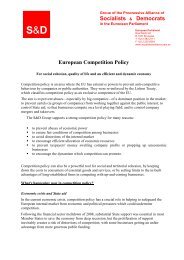Executive summary - Udo Bullmann
Executive summary - Udo Bullmann
Executive summary - Udo Bullmann
- No tags were found...
You also want an ePaper? Increase the reach of your titles
YUMPU automatically turns print PDFs into web optimized ePapers that Google loves.
ownership transfers. But buyout capital looks mainly for significant stable cash flows, forexample in the infrastructure based as their investors are looking for a stable long term returnwith regular dividends and reduced market risk.In general, management companies do not invest in all segments. Most specialise in anindustry or type of investment. They are also differentiated by the value of assets managed,which affects the size of their transactions and defines the profile of the targeted companies.Certain private equity investors have specialized in major shareholder transactions whileothers have focused on smaller investments to build a big portfolio of minority investments.LBOs are investing in a wide range of industries. The analysis is based on fullconsideration of the cash flow opportunities on an industry-by-industry basis in themanufacturing sector and in consumer goods and services.The LBOs buy companies and delist them from the stock exchange. This has the advantagethat they do not have to inform the public about strategies, vital change etc. which areconducted in the boardroom or in the CEO office. It is only the investors who stand behindthe LBO fund, who have access to this information while an eventual minority shareholder orthe public are left outside.The lack of transparency is a huge problem in a democratic society. European labourunions from all over Europe report examples of how LBO funds change the internalorganisation and working conditions of the companies. This group of stakeholders thereforewants to unlock the mystery of the funds.To build their portfolios, manager works at generating the cash flow corresponding to theirinvestment strategies. After completing the analysis process, complemented by prospectivestudies, audits and negotiations, they choose the companies that offer the short-term outlooksthat match the objectives set out in the LBO fund.The manager insists on being close to the central, operational life of the companies.Management companies in the LBO fund will often be represented on boards to take part incrafting strategy to varying degrees. But there again, LBO funds generally insist on totalcontrol.The manager’s ultimate objective is to maximise a return/cash flow - and develop revenuefor its investors. There are several ways to assure these returns and fees: Extraordinaryshareholder dividends, stepped increases in leverage, fees, cuts in jobs, sale or flotation. TheLBO management picks the time and the exit method that will maximize the cash flow.Every three to five years, managers must raise capital on the market or at the time ofcementing an acquisition project. Faced with arbitrages between asset classes and competingprojects, they meet investors to propose new fund investment opportunities and try toconvince them on the basis of their past performance and their professional ability.A distinguishing feature of LBO is that the financial reward of the investors, the investmentmanagement team and the investee company’s management will largely come in stages.Firstly, fees, shareholder dividends. Secondly, fees and value creation realised when exiting56





